Fishing with a can is a unique and creative way to catch fish, and it’s also an affordable and accessible method that anyone can try. It is a popular method among fishermen, especially those who aren’t as eager or need to invest in a fishing setup.
To fish with a can, anglers need some sort of soda can, a fishing line, hooks, bait, and other terminal tackle, depending on the situation. Once the materials are ready, you can attach the line to the top of the can, and when you’ve picked your spot, use momentum to cast the line into the water.
There are various ways anglers are able to fish with a can, so as long as you’re willing to be creative, you’ll have a chance at landing fish.
Materials Required to Fish with a Can
There are a few different materials required to fish with a can. You don’t need much to make it work, so as long as you have the basics, you’re good.
1. Empty Can
If you’re a soda drinker, beer drinker, soup eater, energy drink drinker, or a fan of any other liquid that comes in an aluminum can, you have all you need to get started.
Whatever can you have, make sure it still has the tab on top. Without the tab, you won’t have what you need to keep the line attached.

2. Masking Tape
Masking tape is going to keep the knot you tie to the tab or the top of the can in place. You don’t want your knot moving around too much, so the masking tape is going to keep it in place.
3. 6-8 Pound Test
If you’re fishing with a can, you likely aren’t going after massive fish. Panfish, small bass, pike, small catfish, and other smaller freshwater species are likely the primary targets.
Six to eight-pound test is just about right. It’s thick enough for you to handle and not too thin that it’ll snap if put under a severe amount of pressure. Generally, braid or monofilament will be your best bet.
4. Hook
General J-hooks are what you should use. Size 4/0 or 6/0 hooks are just about right for your can fishing setup.
You can easily attach whatever live bait you’re hoping to use, and they’re not so large that some of those smaller panfish can’t wrap their jaws around it.
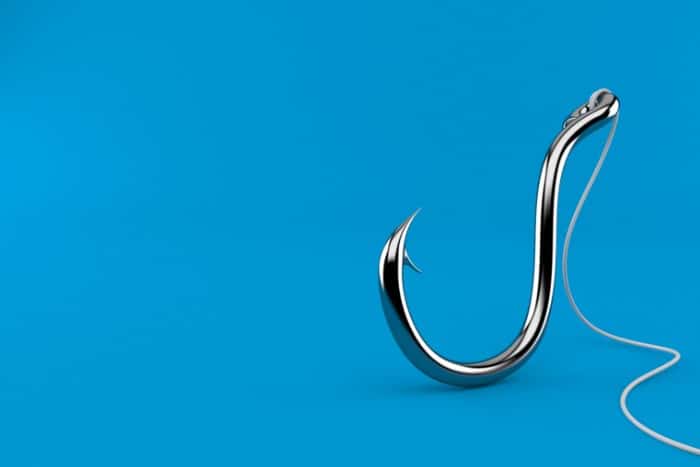
5. Split Shot/Sinkers
Sinkers are a necessity when you’re fishing with a can. Even if you’re fishing with a bobber, you need split shots to keep your bait in place.
When fishing a bottom rig, you need heavier sinkers to keep your bait near the bottom. If you genuinely want to keep it a budget operation, use rocks you find along the banks.
Rocks can be great substitutes for lead sinkers.
6. Bobber
Even if you don’t end up using a bobber, make sure you bring one with you. Bobber fishing is straightforward, and it allows you to sit back and relax and wait for a fish to take it.
7. Knife
You’re going to cut quite a bit of line when fishing with a can, so make sure you have a sharp knife to make your cuts.

Different Ways to Fish with a Can
There are a few different ways to fish with a can, and the method you choose depends on the type of fish you’re trying to land and the locations you’re fishing.
1. Use it As a Reel
The most basic method of fishing with a can is to use it as a reel. Tie the fishing line to the top of the can and cast it into the water.
Once you have a fish, take your bait, or you’re ready to move locations, you can use the can as the reel spool. It takes some getting used to, but it can do the trick in desperate situations.
Anglers who are targeting panfish and other smaller species find this method to work well. Another common method anglers use to make a reel requires them to cut a line in the hole of the can.
When attached, the line is wound around the can and through the hole. The winding of the line prevents the line from ripping off the can in case you hook into a sizable fish.
2. Use it As a Weight
A can will work if anglers are desperate for added weight on their fishing line and are out of lead weights. If anglers fill the can with water or sand, it’ll help keep your bait towards the bottom.
Run your line through the top of a can and let it keep your bait where it needs to be. Many anglers who fish extremely fast-moving water will use this method.
Beware because cans can easily get caught on rocks and logs under the surface and snap your line.
Step-by-Step Instructions
Follow these instructions when you’re setting up your can fishing reel.
1. Attach the Line to Your Can
To attach the line to the can, start by putting it through the hole in the can tab. You’re going to tie the line to the tab, so make sure you secure it with a fishermen’s or surgeon’s knot.
The stronger the knot, the better. Some anglers will put masking tape over the knot to make it even more secure.
2. Make the Reel
After the line is attached to the tab, you can begin wrapping the line around the middle of the can. It’s essential to ensure you are careful with how tightly you wrap the line around the can.
If it’s too loose, it’ll fall off all at once, and you’ll have to begin the process all over again.
If it’s too tight, it won’t unravel at a normal pace, and you’ll find yourself having to start over and readjust to make sure it works.
Generally, you only need somewhere between 40 and 60 feet of line around the can. You’ll likely not need that much line, especially if you are targeting panfish.
If you do hook into a larger fish, you will have enough line to fight it and not get completely spooled.
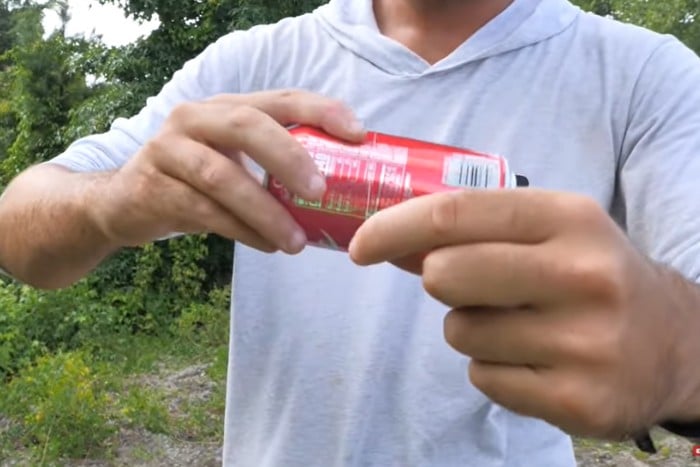
3. Attach the Sinkers, Bobbers, Hook
After you’ve spooled your reel, the next step is to attach the rest of your tackle. Depending on your fishing method, you’ll attach whatever you need.
Do check out my article on the best fishing methods to get some ideas.
4. Casting Your Line
When the can is ready to go, you can begin fishing. As you prepare to cast, unwind your line to about two or three feet past the bobber.
Then, point the bottom end of the pop can at the part of the water you’re hoping your bait hits. Toss the bobber or sinker underhand however hard you like.
Since the bottom of the can is pointed where you would like your bait to hit, the line should naturally unspool and get to the proper place.
After your line hits the water, you can sit and wait for a fish to take it!
Advantages of Fishing with a Can
One of the main advantages of fishing with a can is affordability.
As anglers know, fishing equipment can be extremely expensive. Using a can to fill the role of a rod and reel combo or even a weight can save quite a bit of money.
It’s not glamorous and definitely doesn’t have the same capabilities as even the most affordable fishing reel, but it will work if absolutely necessary.
Another advantage of fishing with a can is how simple it is. You don’t necessarily need any special fishing knowledge or knot-tying skills to make it work.
As long as you have your can and the necessary tackle, you’ll give yourself a chance to fish in all sorts of places.
Whether you’re looking for a change of pace, it’s your only option in a desperate scenario, or are wanting a cheap option, fishing with a can is just for you.
Anglers are often looking for new challenges, so using a can will definitely fill that void. There are dozens of ways a can be used in a fishing scenario, so give it a try and see all the ways you can make it work.
Disadvantages of Fishing with a Can
Depending on your perspectives and needs, fishing with a can have various disadvantages. The obvious disadvantage is how ineffective fishing with it can be.
It doesn’t have the same level of sensitivity, so detecting a strike from a fish is extra challenging. It also isn’t practical when you’re fishing moving water or in more technical situations.
You’ll find yourself needing to make some mends or recast, and nothing moves fast when you’re fishing with a can.
Everything requires time, so if you’re fishing still water, you’ll have more success than when you’re trying to fish with a can on a river or stream.
Another disadvantage of fishing with a can is the lack of versatility. You’re limited to a relatively simple line, hook, and live bait setup.
Fishing with lures and other methods is generally impossible when fishing with a can. You’re stuck casting out your line and waiting for something to strike.
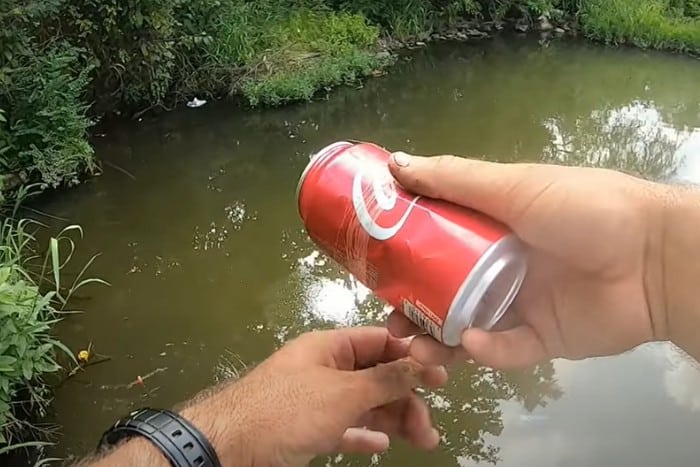
Situations to Fish with a Can
Your best bet for fishing with a can is to spend time in shallow and easily accessible water. Generally, fishing with a bobber or jig setup is your best method to land a fish with a can.
Find structure and cover and cast your bait near it. While waiting for fish to take your bait, be prepared to set the hook and reel the line around the can.
You need to have quick reactions and pay close attention to each twitch in your line.
You don’t have the sensitivity of a rod tip to pay attention to, so make sure you watch your line and observe any sudden movements.
If you find a school of panfish, that’s the perfect time to fish with a can.
You don’t have to make a long cast, you can easily set the hook, and you’ll likely have more than one chance to land a fish, just in case you happen to miss the first fish you find.
Tips for Successful Fishing with a Can
While fishing with a can is fairly simple, there are a few things you can do to make your life a bit easier.
1. Keep the Line Taut
In general, fishing with slack in your line can be a recipe for disaster. If a fish takes your bait, and you aren’t prepared, the fish take your bait and drop the hook before you have time to set it properly.
You’re especially vulnerable when you’re fishing with a can.
As soon as your bait hits the water, take care of the slack and ensure everything is taut. It’ll give you even more of an advantage when you’re hoping to land fish.
2. Stick with Live Bait
Fishing with a can is already challenging enough, so to give yourself the best opportunity to land fish, stick with live bait.
Worms and minnows are natural attractants for fish of all types, so if you want success when fishing with a can, start with live bait.
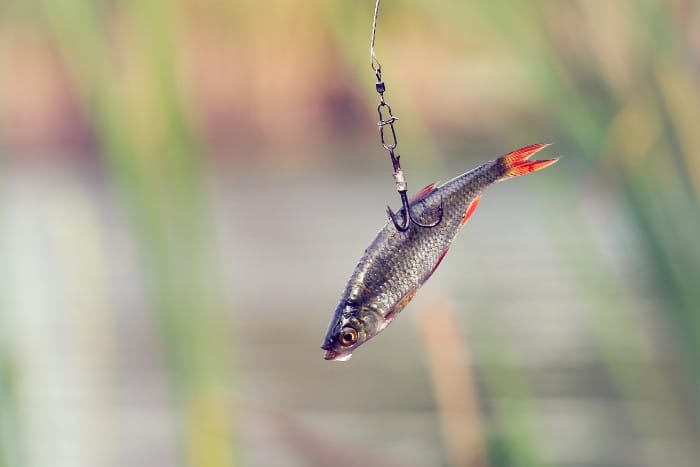
3. Practice Casting Before You Visit the Water
Casting with a can takes quite a bit of getting used to, so feel free to try it on your lawn or at a local park. The more prepared you are with casting before you make it to the water, the better off you will be.
When you’re on the water, you want to spend more time fishing and less time learning how to cast.
4. Stay Hidden
Since you aren’t going to be able to make as long of casts as you usually would with a fishing rod and reel, you’re going to have to stay as hidden as possible.
Keeping yourself out of direct sunlight and as far away from the fish as you can is going to give you a better chance to land fish. Fish are easily able to see shadows and get spooked.
5. Set the Hook with The Line in Your Hand
When you’re setting the hook, make sure you have at least one hand on your fishing line. If you rely on the can to take the pressure of a fish, it can easily break.
Keep the can in one of your hands and the line in the other. Let the hand with the line in it be the first to set the hook, and then the rest of the line will fall onto the can and you can begin the retrieval process.
As you’re retrieving, don’t be afraid to guide the line with your hand. You can almost use a similar tactic as to what you would do if you were fishing with a click-and-pawl reel.
You have to set the drag resistance and make sure the entire process is running smoothly.
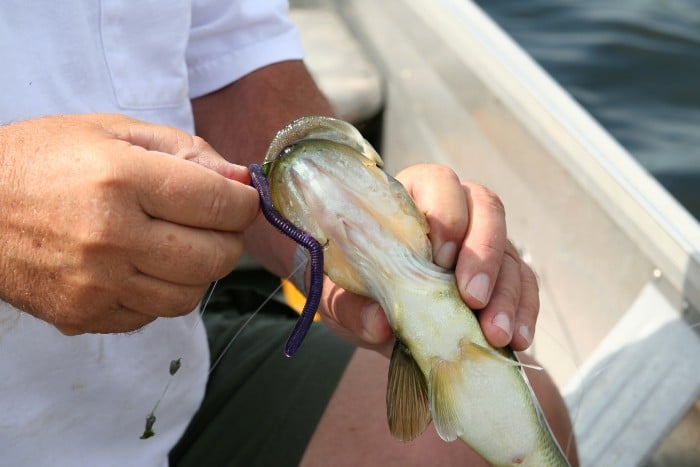
Conclusion
Fishing with a can is an old-school method of landing fish. It requires only the basic materials, and it can actually be quite successful.
While many anglers would scoff at the idea of trying to fish with a can, it can be quite fun and present a new challenge.
You’ll also gain a new appreciation for the high-quality technology we have as modern-day anglers. So, grab your favorite soda can, some line, a few weights, hooks, and your bait, and hit the water.
You’ll definitely leave with a new appreciation for anglers who do this on a regular basis.
